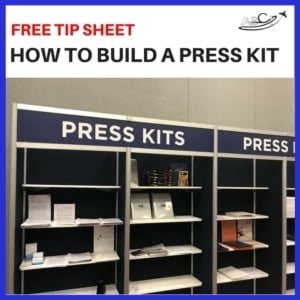[embedyt] https://www.youtube.com/watch?v=pkq-x4uMpro[/embedyt]
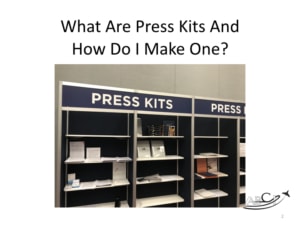 “What is an aviation press kit, why do I need one, and how do I make one?” In this episode, we talk about these and other questions:
“What is an aviation press kit, why do I need one, and how do I make one?” In this episode, we talk about these and other questions:
Why Should I Have A Press Kit?
Publicity is a good thing for any aviation company. “Getting ink” in Aviation Week, AIN, General Aviation News, DOM or any of the other popular aviation publications is a worthy goal. for any company that sells and aviation-related product or service. There is nothing like the credibility that comes from having the logo of a respected magazine with a “As seen in. . . next to it on your website or in your marketing materials.
Press Releases are key to ensuring the press is aware of your news items, but often it’s not enough. Many aviation products and services are highly technical. Or there are technical circumstances surrounding them. And many reporters are not familiar with the concepts involved with your product or service. Reporters are often asked to cover stories outside their usual “beat.” So they may not have enough information to feel comfortable publishing your news.
You market your products or services to your ideal customer by “stepping into the customers’ shoes.” You consider things from his or her perspective.
What questions do they have? What concerns do they have? How can you address them most conveniently?
Do the same thing with journalists who cover your specialty – what questions would or should they ask? (Especially if they don’t specialize in your area!) What information, photos, charts and graphs might they want? What kind of background information would help them write about your subject more confidently?
What Goes In a Press Kit?
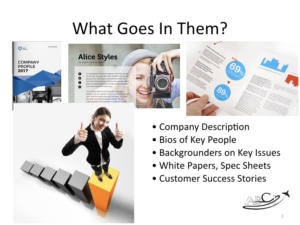 With those questions in mind, consider the marketing materials you currently have. If any of these items are missing, outdated, or lackluster, consider updating them or creating new ones for your aviation press kit.
With those questions in mind, consider the marketing materials you currently have. If any of these items are missing, outdated, or lackluster, consider updating them or creating new ones for your aviation press kit.
Some contents to consider:
-
A company description, origin story and/or profile
-
Bios of key people
-
Backgrounders on key issues and concepts
-
White papers, spec sheets, product sheets
-
Customer success stories, testimonials, case studies
-
Charts, graphs, photographs and logos in high-resolution, printable formats.
-
And of course, your current press release or releases.
The quality of these materials is incredibly important.
Boring materials are of no use to a journalist with a “nose for news.” Journalists look for
- Startling statistics.
-
Amazing facts.
-
Interesting stories,
-
Eye-catching charts, graphs and photographs
-
Anything else they feel will attract the attention of their readers.
Ensure each piece is branded with our company’s logo, fonts and visual cues, and includes contact information. (Materials sometimes get separated from the kit or passed around among team members.)
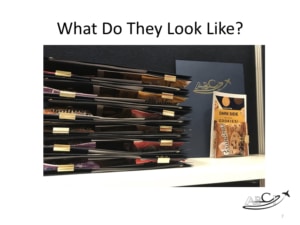
What Do They Look Like?
There are a number of ways to deploy your Press Kit, think about this as a packaging expert. How can you make this material attractive and easy to use? We like high-quality portfolios with a company logo that can be used for multiple purposes, including this one. (Here’s ours!)
We still use printed materials, since our journalist friends may have limited equipment (aka – a tiny laptop) at a show or event.
Printed materials are easier to read and make a bigger impact than online materials. This is particularly true if the printing is high-quality and visually attractive.
We include treats such as cookies.
This is a subtle “bribe” to get our packets picked up. They stand out from the others on the rack! This also shows our appreciation for hardworking reporters who often don’t get regular meals or breaks while working a show.
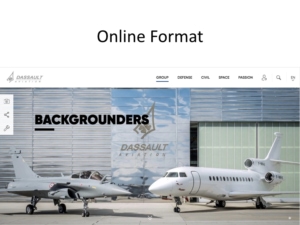 An online press it is an ideal supplement to the a physical one. You can also include a CD or jump drive with your documents in softw copy, but ensure each document includes a link to the online version. This way journalists can cut and paste text and download images and other materials.
An online press it is an ideal supplement to the a physical one. You can also include a CD or jump drive with your documents in softw copy, but ensure each document includes a link to the online version. This way journalists can cut and paste text and download images and other materials.
Online press kits can be specific to the trade show, or “perennial.” Perennial, in this sense, meaning that you leave it available on your website all year round and refer to it as you interact with reporters.
Larger companies often have a “media room” or “press” link on their website where journalists can obtain the information they want and need.
Using a “perennial” or “evergreen” press kit is a great strategy. But its important to review and update the materials on a regular basis. This will help your materials remain credible. If an opportunity arises for a story, journalists are using your current statistics and materials.
With those questions in mind, consider the marketing materials you currently have, and consider creating new ones for your aviation press kit.
Some contents to consider:
- A company description, origin story and/or profile
- Bios of key people
- Backgrounders on key issues and concepts
- White papers, spec sheets, product sheets
- Customer success stories, testimonials, case studies
- Charts, graphs, photographs and logos in high-resolution, printable formats.
- And of course, your current press release or releases.
The quality of these materials is incredibly important.
Boring materials are of no use to a journalist with a “nose for news.” Journalists look for startling statistics, amazing facts, interesting stories, and eye-catching charts, graphs and
Related Articles:
You might also enjoy our Webinar on Aviation PR
How to Write Press Releases that get noticed, and prepare ideal Public Relations (PR!) messaging for an Aviation Company
- “Why do my competitors always get mentioned in aviation publications and magazines, and WE never do? Our product is much better!”
- “Do you HAVE to spend a fortune on advertising to get mentioned in the industry press?”
- “How do we handle the press if we have a negative incident on the field or that’s associated with us in some way? How do we keep from being a cautionary tale? Should we talk to the press or avoid them? Is ‘no comment’ better than providing information?
We answer all these questions and more about aviation press releases and publicity in this webinar.
 “What is an aviation press kit, why do I need one, and how do I make one?” In this episode, we talk about these and other questions:
“What is an aviation press kit, why do I need one, and how do I make one?” In this episode, we talk about these and other questions:  With those questions in mind, consider the marketing materials you currently have. If any of these items are missing, outdated, or lackluster, consider updating them or creating new ones for your aviation press kit.
With those questions in mind, consider the marketing materials you currently have. If any of these items are missing, outdated, or lackluster, consider updating them or creating new ones for your aviation press kit. An online press it is an ideal supplement to the a physical one. You can also include a CD or jump drive with your documents in softw copy, but ensure each document includes a link to the online version. This way journalists can cut and paste text and download images and other materials.
An online press it is an ideal supplement to the a physical one. You can also include a CD or jump drive with your documents in softw copy, but ensure each document includes a link to the online version. This way journalists can cut and paste text and download images and other materials.

